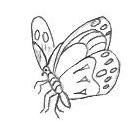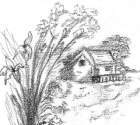Search for images or info
Cartoon Animals
I love drawing cartoon animals because they are not stressful to do. Actually, they make a very easy subject and they sit still!

There's all that white space that you can use to your advantage. You only need to add a few lines and the result is a great comic-like drawing.
Once you start practicing by copying some outlines, you end up with these happy little critters staring up at you from the page.
It doesn't matter if your cartoon sketches are not exactly right because there are no rules in animation.
If the cartoon looks good to you - after another critical viewing by you tomorrow - then it's obviously fine, so don't sweat it.


Cats and dogs are very popular topics and I found these examples to be extremely easy to copy.
Good luck with your copies, I hope you have great success, too.
I particularly like the dog illustration, it reminds me of a canine character that was on television when I was younger - I think he's cute, anyway!
Sometimes, if I'm copying a drawing, I use my pencil as a rough gauge to measure the subject and I make little marks on my paper for the height and width.
This is a very useful trick which helps me keep the drawing in perspective. Otherwise, I just draw and erase until I think it looks right - I'm a pretty casual hobby artist.
Tips For Animals
I decided to experiment with shading on the buzzard. At this stage, I have been teaching myself to draw for about one year while concentrating mainly on drawing outlines.

For something different, I used the cross-hatch method and it was quite suitable with my fine mechanical pencil.
Cross-hatching is when you draw closely spaced lines together then go back over that with lines going in the opposite direction. Up and down, or on an angle, it doesn't matter.
You can vary the length of your lines and how close they are. Then, you can use different pencils for varying thickness, light or dark. Fun, hey?
The only way for you to know if it suits you is to trial it on one of your drawings. Cross hatching can achieve many different effects and you'll likely come up with some great ways to use it.
Once I was finished the drawing, I used a cotton tip to blend the area. You have to take care when you do this, so you don't smudge outside the lines. If you do this accidentally, just use a kneaded eraser to dab at the smudged area. It's finnicky work so it's best to avoid it in the first place.
To prevent ruining a drawing, keep your hand off the drawing surface by turning the paper around at different angles when you make changes to a drawing. Another alternative is to place a clean scrap piece of paper under your hand.

Categories
Sketches
Instruction
Freebies
Other Areas

A bull isn't normally a very happy cartoon character. You can make characters more fun by adding in some symbols to give the illusion of clouds of dust, or whatever. Just that tiny bit of detail makes the cartoon animals come to life.
If you enjoy fantasy, try creating a basic animated dragon. Since visual effects are encouraged, this dragon is breathing smoke and fire.

I don't think this is a good drawing because a friendly-looking dragon like this one would not be flaring his nostrils. It's something for me to remember next time.
My cartoon animals are shown here in actual size so I hope you can see them clearly to copy successfully. So, there you have it - simple sketches for everyone!
Click a link below to view more cartoony illustrations:
Extra articles for you to enjoy...
* Allaboutdrawings.com is a participant in the Amazon Services LLC Associates Program, an affiliate advertising program designed to provide a means for sites to earn advertising fees by advertising and linking to Amazon.com.
Copyright © 2005 - 2025 www.allaboutdrawings.com. All rights reserved.










